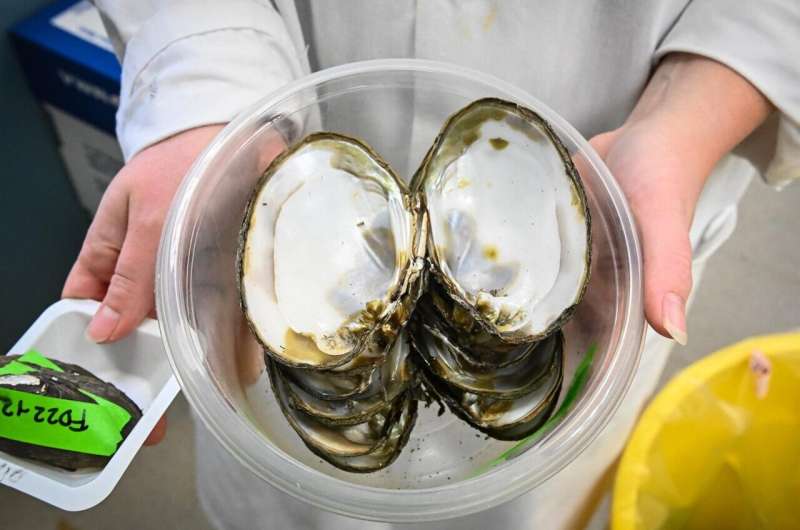This article has been reviewed according to Science X's editorial process and policies. Editors have highlighted the following attributes while ensuring the content's credibility:
fact-checked
peer-reviewed publication
trusted source
proofread
Mussels downstream of wastewater treatment plant contain radium, study reports

Burrowed into streambeds and rarely moving for their decades-long lifespans, freshwater mussels are biomonitors, meaning they indicate how clean their environment is, according to Penn State researchers. As the bivalves feed on organic matter and filter the water around them, their inner tissues and hard shells begin to reflect whatever is in their environment—including radioactive particles.
A pair of researchers from Penn State's Department of Civil and Environment Engineering (CEE) analyzed the composition of mussels downstream of a centralized treatment facility in Western Pennsylvania that had accepted and treated fracking wastewater from the oil and gas industry for at least two decades. The now-decommissioned facility stopped accepting oil- and gas-produced wastewater in 2019.
The researchers found that, even years later, the tissue and shells of mussels contained radium that could be traced to wastewater from fracking in the Marcellus Shale. The rock formation stretches underground from West Virginia through New York and is the largest natural gas field in the country. Their findings are available online now and will appear in the June issue of Science of the Total Environment.
Though most facilities in Pennsylvania do not accept oil- and gas-produced water now, from 2008 to 2011, Pennsylvania's rivers and streams saw a significant volume of treated wastewater that originated from fracking in the Marcellus Shale. Wastewater treatment facilities remove major contaminants, including radium, before discharging the water into surface water, like rivers, according to researchers. However, the treated water still contains trace amounts of contaminants and is five to 10 times saltier than ocean water.
"With a much higher salinity than the surrounding environment, the discharged water has a different chemical fingerprint than what the mussels are used to," said Nathaniel Warner, professor of CEE and corresponding author on the paper. "Mussels that were closest to the water discharges died off. Further downstream, the mussels found a way to tolerate the salinity and radioactive materials and instead absorbed them into their shells and tissues."
He explained that other types of wastewater generally do not contain many radioactive particles, but oil and gas wastewaters found deep in the earth and brought out by fracking often contain specific unique element ratios—a kind of signature that can be traced. The unique ratios of radioactive elements allowed the team to identify that the source of the contaminants is likely the treated Marcellus Shale wastewater.
To collect the samples for radium analysis, Katharina Pankratz, a doctoral candidate in CEE and first author on the paper, contacted the Pennsylvania Department of Environmental Protection (DEP) to get a permit to sample mussels in the Allegheny River. DEP biologists, who offered to help with collection, identified the species that were present, then randomly collected 10 eastern spikes—a common type of mussel—from four designated locations along the river.
The researchers found that half a kilometer downstream of a discharge site, mussels had approximately double the total radium levels as those upstream of the discharge site. And mussels five kilometers downstream of a discharge site had less than the mussels closer to the site, but still had a measurable amount of radium.
Radiation exposure is measured in dose units known as micro-Seiverts (μSv). The researchers compared the radioactivity of the sampled eastern spikes to Brazil nuts, which take up radiation from the soil in which they grow. A 28-gram serving of Brazil nuts contain 0.47 to 0.80 μSv, while the maximum value calculated for a single mussel collected by researchers in the study was 63.42 μSv. The International Atomic Energy Agency recommends that individuals limit their annual exposure to no more than 1,000 μSv. Any more exposure can lead to health problems.
"Along with nutrients, mussels also filter contaminants present in the water column, like metals, microplastics, synthetic chemical compounds and other emerging contaminants of concern," Pankratz said. "Depending on the contaminant and its chemistry, if it is small enough to pass through the gills of the mussel, it has the potential to accumulate in their tissue or precipitate within the hard-shell structure."
While these mussels are not harvested for human consumption, larger species, like waterbirds, raccoons, muskrats and otters, regularly eat freshwater mussels, meaning the contamination could pass up the food chain, Pankratz said.
"It raises concerns about potential impacts on other aquatic life, particularly endangered species more vulnerable to contaminants," she said. "This information may help shape future regulations for wastewater disposal to surface water, especially in regions where mussels are harvested for food. I hope this study will inspire further research into the ecological consequences of these disposals worldwide."
More information: Katharina Pankratz et al, Radioactivity from oil and gas produced water accumulated in freshwater mussels, Science of The Total Environment (2024). DOI: 10.1016/j.scitotenv.2024.172151
Journal information: Science of the Total Environment
Provided by Pennsylvania State University




















